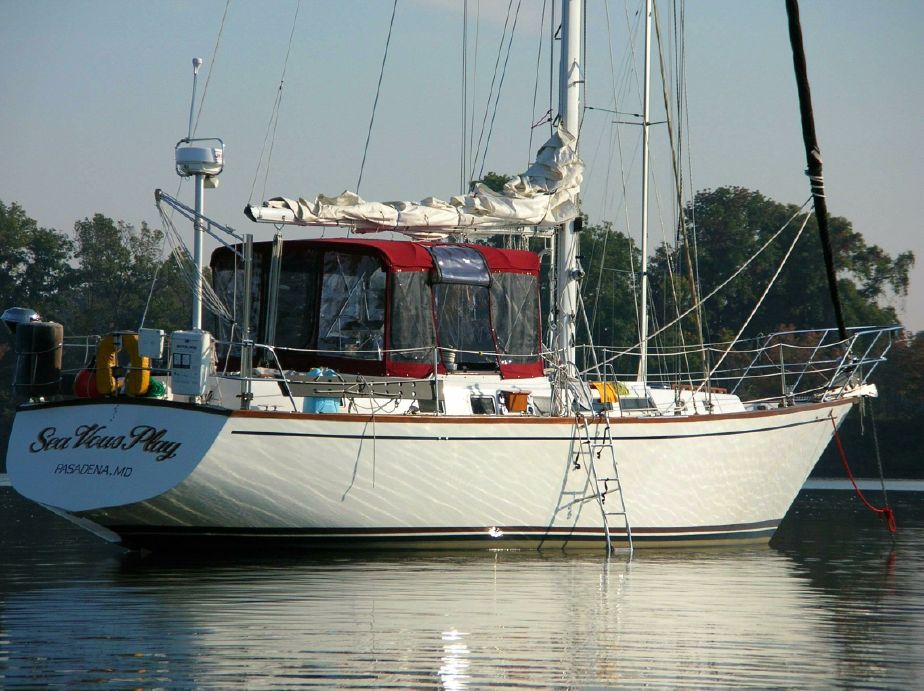What’s a good, affordable liveaboard cruiser? This is a question I am often asked and what makes it impossible to answer of course, is that good and affordable both must be defined by the boat buyer, not me.
Every used boat buyer must make compromises between condition, performance, quality, comfort and cost. You can’t reasonably expect to improve on one without sacrificing another, and boat shoppers who try will become frustrated quickly. But, after shopping around, a fair number could find the Endeavour 42 on their short list of boats to consider if their interest lies in an affordable liveaboard cruiser.
The Endeavour 42 is a contemporary, center-cockpit design that, to my eye, does a good job of disguising the high freeboard and boxy trunk cabin of center-cockpit models in this size range. It was introduced in 1985, remained in production until 1991, and is perhaps best recognized as the liveaboard home of "Miami Vice" detective Sonny Crockett and his pet alligator Elvis. The length over all is 42’3", waterline length is 33’4", beam is 13’, draft is 5’, and designed displacement is 25,500 lbs.
There is nothing unusual or extraordinary about the construction of the 42.
The hull and deck are both fiberglass composites with balsa wood or plywood coring. There is no core used in the hull below the static waterline, but special care must be taken when locating fittings in the hull side that penetrate balsa-cored areas to ensure the balsa core is sealed against possible leaks at normal angles of heel.
Typical of production-built boats, there is considerable use of fiberglass liners and veneered plywood joiner work on the interior that makes access and thorough inspection difficult at best. The areas under the berths and settees are accessible for inspection of attachments of structural components, and the quality of the work is about what is expected of boats in this price range. The biggest potential I see for expensive repairs lies in the installation of the fuel and water tanks. All are welded aluminum, and all are in the bilge and keel. For such installations, 10 to 15 years is a reasonable life expectancy, and anything past 15 years is living on borrowed time. The fuel tank is below the engine, so replacing and service require removing the engine. Replacement of water tanks would require removing the cabin sole. These repairs can get very expensive. I know of a recent keel tank replacement on a similar sized boat that required a near total disassembly of the cabin interior. The final replacement cost exceeded $60,000.
The decks of the 42 are well laid out with a large anchor locker forward, a shallow bulwark around the deck for secure footing, comfortable center cockpit and port and starboard aft deck lockers. There are five opening deck hatches and convenient grab rails on the cabin top for added security.
The Endeavour 42 offers very comfortable accommodations for weekend sailors as well as the long-term liveaboard cruisers. There is a very spacious V-berth cabin forward followed by nearly 5’ of hanging locker space along the starboard side and head with shower to port. The main saloon features a starboard settee that extends to make a double berth and a circular dinette to port. There is a small but efficient navigation station to the starboard aft corner of the saloon. The galley is in the port passageway between the saloon and the aft stateroom and features a large top-loading icebox and freezer, gimbaled stove and oven and double stainless sink. Storage in the galley is a bit limited, particularly if the boat is equipped with an auxiliary generator that is located beneath the galley sink. The aft stateroom has a center-island double berth, large hanging locker and private head and shower.
Auxiliary power is provided by a 62 Perkins diesel that is plenty of reserve power for the moderate displacement of the 42. Sail area, with working sails is a conservative 788 sq. ft., which results in a little sluggish performance in light air, but otherwise speed and windward ability are very respectable for a center-cockpit cruising design. Several months ago I made reference to a design’s "Comfort Ratio," and a reader has e-mailed asking about the meaning of this number. Because this is a cruising design, with emphasis on comfort, this would seem an appropriate time to take a look at this ratio.
The comfort ratio number was developed by naval architect Ted Brewer as a simple means of comparison of how comfortable the expected motion of a boat might be. The number results from comparing the LOA, LWL, maximum beam and displacement. A higher number indicates a boat that would be expected to have a slower motion and therefore be more comfortable at sea. The Comfort Ratio of the Endeavour 42 is 34 and, for comparison, the average of 100 boats, in my database, between 41’ and 43’ is 31.7. This is not as sophisticated an evaluation tool as Strip Theory and Computational Fluid Dynamics computer programs used by naval architects, but it can be derived by a little simple math, and can be quite useful when comparing boats of similar overall length. For those interested, the formula for calculating Brewer’s comfort ratio is - Displacement/(.65x((.7XLWL)+(.3XLOA))xBeam1.333)
In five years of production there were nearly 100 Endeavour 42s built, and a thorough check of the market will generally turn up several used models offered for sale.
Reviewed in the September 2000 issue of SpinSheet by Jack Hornor





